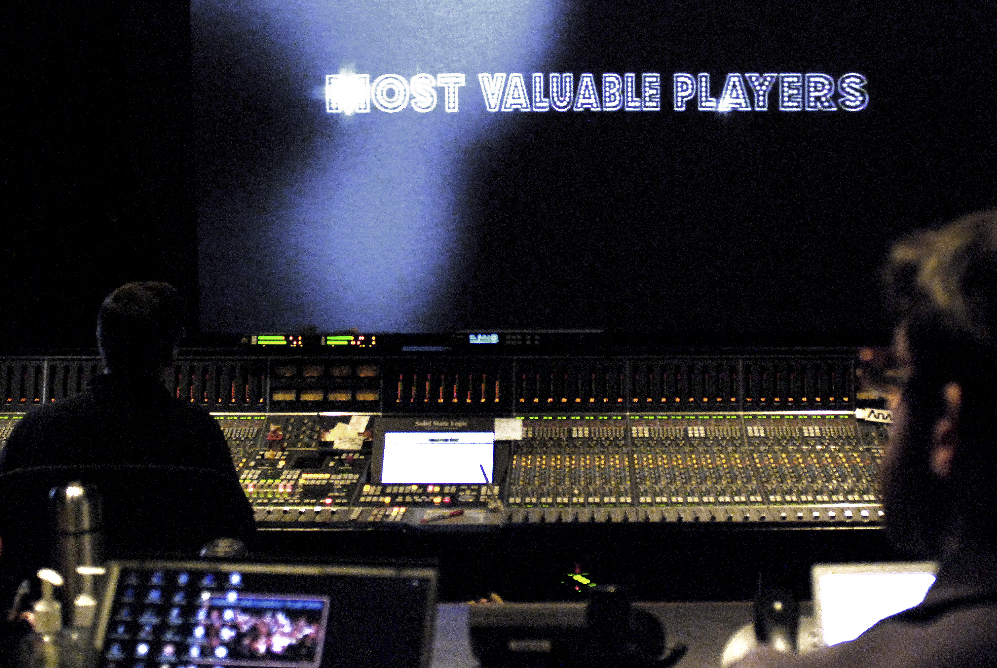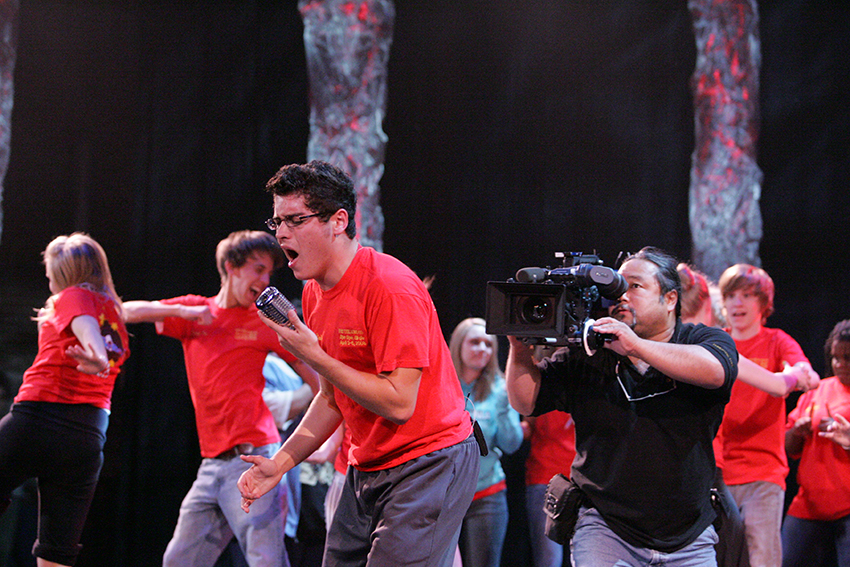About the Film
MOST VALUABLE PLAYERS is an award-winning documentary that follows three high school theater troupes on their journey to the Freddy Awards ceremony - the Tony Awards for high school musicals. The film demonstrates that arts education encourages the same teamwork, camaraderie and confidence as sports.

Synopsis
Across the USA, high school sports are regularly lavished with funding, publicity and scholarships, while theater departments struggle to put on the school musical hoping for some attention of their own. It's no different in the sports crazy Lehigh Valley, PA, except for the "Freddy Awards," a live television event that recognizes excellence in local high school musical theater. Illustrating that arts education encourages the same teamwork, camaraderie and confidence as sports, MOST VALUABLE PLAYERS follows three theater troupes on their creative journey to the elaborate award ceremony - the "Super Bowl" of high school musical theater.
MOST VALUABLE PLAYERS demonstrates arts education in action, reminding us why the performing arts must remain vital in the lives of young people. In the face of shrinking budgets, schools and communities must band together to preserve and nurture arts education.
Arts Statement
As a society, we cherish our music, movies, TV shows, stand-up comedians, books and Broadway too. Yet when school budgets shrink, the first thing that gets cut is the arts – as if it’s merely a disposable afterthought to education.
The arts in schools are the perfect way to help apply the more basic skills of reading, writing and arithmetic. Interpreting scripts, building sets, making costumes, learning to dance or read music utilize all sorts of classroom skills put to use in a more active and fun application. The arts help keep kids off the streets, create expectations and set goals, offer opportunities of unique expression, build self-esteem, encourage friendships and camaraderie, create extended families and teach valuable life skills and lessons.
In California, Assembly Bill 2446, awaiting signature by the Governor, will do away with arts education as a graduation requirement for high school vocational students. (The theory behind the bill is that making the arts an elective will reduce drop-out rates). Other states, cities and communities continue to limit or eliminate the arts in school systems. This could create a generation of students without an appreciation of the arts.
MOST VALUABLE PLAYERS demonstrates the importance of the arts and how schools and the arts community can band together - in spite of their individual struggles - to create a worthwhile program that enriches the lives of all, while contributing to self-preservation.
The arts can survive and even thrive in spite of narrow-minded legislators and budget cuts. Communities can make a difference. After a huge public outcry, the L.A. Unified School District recently relented and now intends to cut the arts budget by a 1/3 instead of 50% as previously planned. The district has also backed away from an idea to entirely eliminate all elementary arts programs next year.
There are currently 32 other high school musical theater awards programs around the USA - like the one featured in MOST VALUABLE PLAYERS. They feed into a new national program that provides four-year college scholarships to two winning students. Other great efforts like The International Thespian Festival and Camp Broadway strive to keep the performing arts essential in the lives of young people. But it won’t be enough until all students have access to these opportunities. The key to success of such efforts is the partnership between the communities, local arts organizations and the schools.
Providing access to arts opportunities insures the encouragement and nurturing of the musicians, filmmakers, performers, writers and creators of tomorrow. Furthermore, our future doctors, lawyers, civil servants, engineers and business people will benefit too, as they become more dimensional individuals with an understanding and appreciation of the arts – which can lead to their support of the artistic community and the overall survival of the arts for future generations.
We hope MOST VALUABLE PLAYERS inspires communities to rethink their commitment to arts education by supporting these vital programs or creating their own. Ultimately, arts education is about engendering the skills necessary to become intelligent, empathic and whole human beings. As Beverly Sills once noted, “Art is the signature of civilization.”

Behind the Scenes
MOST VALUABLE PLAYERS began when writer/producer Christopher Lockhart stumbled upon a clip of the Freddy Awards on YouTube in 2007. Coincidentally, that year’s ceremony was to be webcast the very next day. The Los Angeles resident hunkered down in front of his computer screen for 3+ hours and watched the event unfold live.
The award ceremony is the brainchild of former PBS producer and on-air talent Shelley Brown, who now serves as CEO of the State Theatre in Easton, Pennsylvania. Wanting to get the local youth involved in the 100-year-old theatre, she founded the award ceremony in 2003; she modeled it after Broadway’s Tony Awards. Brown named the award after J. Fred Osterstock, the ghost of the former theater manager who, legend has it, haunts the space. Given her television experience, Brown convinced independent TV station WFMZ to air the Freddy Awards live – which is broadcast into millions of local homes.
Having been a theater geek in high school, Lockhart immediately related to the event. He had always wanted to find a way to communicate the benefits of arts education in an emotional way rather than a thesis. He envisioned a documentary and took the idea to filmmaker Matthew D. Kallis. The two had worked previously on a TV special for the local L.A. market – which earned them Emmy nominations.
Kallis had also been involved in theater at Beverly Hills High School, but his formal education took him to M.I.T. and Columbia, where he studied technology, business and finance. His roots, however, were steeped in the arts, as his parents are artists and supporters of the arts through the Al and Trudy Kallis Foundation. Kallis took to the idea, and the two formed a partnership.
Lining up their ducks in a row included having to introduce themselves to Shelley Brown and convince her that the Freddy Awards was worthy of a documentary and that they were the filmmakers to trust. A visit in January 2008 enabled Kallis and Lockhart to meet Brown and her entire staff. A bond was formed and they were given the green-light.
Kallis and Lockhart recruited Emmy winning cinematographer Curt Apduhan and Emmy winning production sound mixer Ken King. Some local crew was hired to round out the small team. They started shooting in February 2008. With 28 schools participating in the Freddys that year, it was impossible to cover all of them. During the story stage of planning, Kallis and Lockhart were attracted to Parkland and Emmaus High Schools. Statistically speaking, both schools had done well at past Freddy ceremonies. Furthermore, they were big cross-town rivals in sports, and the Freddy Awards had now created some competition between their theater programs. Adding to the conflict was the fact that both schools decided to do the popular Les Miserables and on the same weekend.
At the recommendation of Freddy coordinator Vic Kumma, the filmmakers visited Freedom High School to interview drama teacher Jennifer Wescoe. They were overwhelmed by her genuine enthusiasm and the energy of her students. It soon became apparent that Wescoe, three of her students and the school would be the heart of the documentary.
Bad news hit the State Theatre when it was revealed that Vic Kumma was diagnosed with very late stage melanoma. The filmmakers discussed whether or not it was a subject they wanted to cover in a documentary about the arts. Kumma gave them full access to his situation but did not want it to overwhelm or detract from a documentary about the Freddy Awards. Because the theater community rallied around Kumma – even raising over $20,000 to fly his Seattle relatives in for the big ceremony – it seemed disingenuous not to include Vic’ story.
Although the filming of the documentary was primarily done with two cameras, the actual Freddy Award ceremony was covered with eight cameras (a few of them stationary) plus the live TV footage captured from WFMZ. In pre-production, the benefits of the live TV coverage seemed like a plus. However, during the live event, the documentary cameras were forced to the sidelines to avoid crashing into the TV station’s camera crew. The station also decided last minute not to broadcast in high definition, which would create some headaches in post-production.
The day after the awards, the crew shot the reactions of the teachers and wrapped at the end of the day.

Editor Zack X. Braff began cutting the film on October 1, 2008 while Lockhart wrote the script. Kallis oversaw all aspects of the grueling and complicated digital post-production with only a minimal budget. Meanwhile, composer Randy Miller was hired to write the original score, which was recorded using a full orchestra of studio musicians. In late 2009, the film was finally ready for on-line finishing at the world-famous Technicolor facilities in Hollywood.
The title of the documentary came last. The working title had been “Freddy Fever,” but through the evolution of putting the film together, it became less about the award ceremony and more about the students who benefit from it. The film’s thesis states that arts provide the same benefits as high school sports – something that the sports crazy region, where the documentary was shot, has come to learn. “Most Valuable Players” was decided upon, as “players” refers to both athletes and actors, and young artists are definitely valuable.
An advanced screening and first public performance of the film was held on April 16, 2010 at the State Theatre Center for the Arts in Easton, Pennsylvania. The 1,500-seat venue was packed, and the audience cheered upon seeing the opening shots of their hometown.
MOST VALUABLE PLAYERS made its theatrical debut in August 2010 via the International Documentary Association’s DocuWeeks Theatrical Showcase, the dual coast run (at the IFC Center in NYC and the Arclight Theater in Hollywood) made the film eligible for the Oscar. Two months later, it made its film festival premiere at the Mill Valley Film Festival outside of San Francisco. Other festivals followed, including the Dallas International Film Festival and the Nashville Film Festival, where MVP won the “Documentary Channel Audience Award.” The film played in Toronto, New Zealand, St. Louis and many other festivals around the world.
During this time, the yet-to-be-born Oprah Winfrey Network (OWN) was planning, as part of their programming, a documentary club – modeled after Oprah’s book club. The OWN network acquired MOST VALUABLE PLAYERS in late 2010. It premieres on September 8, 2011 at 9PM ET/PT, which will be followed by the release on home video.
In January 2011, the filmmakers flew to the Sundance Film Festival to meet Oprah Winfrey and hear her publicly announce the acquisition of their film as a charter selection for the OWN Documentary Club.
Partial Crew List
- Matthew D. Kallis (Director, Producer) — IMDB Listing
- Christopher Lockhart (Writer, Producer) — IMDB Listing
- Curt Apduhan (Director of Photography) — IMDB Listing
- Ken King (Production Sound Mixer) — IMDB Listing
- Zack Braff (Editor) — IMDB Listing
- Randy Miller (Composer, Original Score) — IMDB Listing